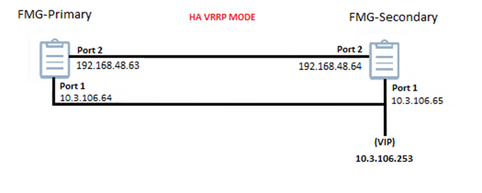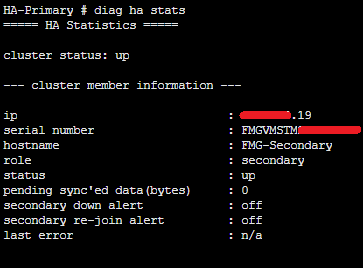- Support Forum
- Knowledge Base
- Customer Service
- Internal Article Nominations
- FortiGate
- FortiClient
- FortiADC
- FortiAIOps
- FortiAnalyzer
- FortiAP
- FortiAuthenticator
- FortiBridge
- FortiCache
- FortiCare Services
- FortiCarrier
- FortiCASB
- FortiConverter
- FortiCNP
- FortiDAST
- FortiData
- FortiDDoS
- FortiDB
- FortiDNS
- FortiDLP
- FortiDeceptor
- FortiDevice
- FortiDevSec
- FortiDirector
- FortiEdgeCloud
- FortiEDR
- FortiEndpoint
- FortiExtender
- FortiGate Cloud
- FortiGuard
- FortiGuest
- FortiHypervisor
- FortiInsight
- FortiIsolator
- FortiMail
- FortiManager
- FortiMonitor
- FortiNAC
- FortiNAC-F
- FortiNDR (on-premise)
- FortiNDRCloud
- FortiPAM
- FortiPhish
- FortiPortal
- FortiPresence
- FortiProxy
- FortiRecon
- FortiRecorder
- FortiSRA
- FortiSandbox
- FortiSASE
- FortiSASE Sovereign
- FortiScan
- FortiSIEM
- FortiSOAR
- FortiSwitch
- FortiTester
- FortiToken
- FortiVoice
- FortiWAN
- FortiWeb
- FortiAppSec Cloud
- Lacework
- Wireless Controller
- RMA Information and Announcements
- FortiCloud Products
- ZTNA
- 4D Documents
- Customer Service
- Community Groups
- Blogs
- Fortinet Community
- Knowledge Base
- FortiManager
- Technical Tip: FortiManager HA cluster setup and t...
- Subscribe to RSS Feed
- Mark as New
- Mark as Read
- Bookmark
- Subscribe
- Printer Friendly Page
- Report Inappropriate Content
| Description |
This article describes how to configure and troubleshoot a FortiManager High-availability (HA) cluster in Manual and VRRP mode. |
| Scope | FortiManager, HA. |
| Solution |
Notes on HA modes for FortiManager: Must be the same between the Primary and all other nodes of the cluster:
Note: Starting from version 7.4.x and forward, it can be deployed on various types of machines. For example, the Primary device uses KVM, and the secondary uses VMware ESXi. The steps to configure HA are unchanged.
Note: The virtual IP should be the same in both Primary and Secondary devices. (VRRP mode).
Sample Diagram with Port & IP Configuration:

FortiManager HA settings: Below are the HA settings of the FortiManager HA cluster and their meanings:
Failover Mode: <Manual> or <VRRP> (VRRP or automatic HA failover mode will be covered later in this document).
Operation Mode: <Primary> or <Secondary>.
Cluster Settings: Peer IP: <Secondary FortiManager IP address>. Peer SN: <FMGVMXXXXXX> (Secondary FortiManager Serial Number).
The HA settings below must be the same on the Primary & Secondary nodes:
Cluster ID: Any number (1-255) can be given. Group Password: <password>. It is possible to give any password. File quota: 4096. Heartbeat Interval: <Interval_Integer>.
The time the primary unit waits between sending heartbeat packets is in seconds. The heartbeat interval is also the amount of time that the backup unit waits before expecting to receive a heartbeat packet from the primary unit. The default heartbeat interval is 5 seconds. The heartbeat interval range is 1 to 255 seconds. Users cannot configure the heartbeat interval on the backup units.
Failover Threshold: <Interval_Integer>. The number of heartbeat intervals that one of the cluster units waits to receive HA heartbeat packets from other cluster units before assuming that the other cluster units have failed.
The default failover threshold is 3. The failover threshold range is 1 to 255. Users cannot configure the failover threshold of the backup units.
The settings below can only be configured when the Failover Mode is VRRP:
VIP: <Virtual IP address>. This setting can only be configured when the Failover Mode is VRRP (Make sure this IP is not used in the network).
VRRP Interface: <port>. Priority: <1-253>. Set the priority for this device between 1 (lowest) and 253 (highest). The device with a higher priority will operate as the primary unit when possible.
Unicast. Optionally, toggle this setting ON to use Unicast for the VRRP message.
Monitored IP. Configure the monitored IP and interface. Users can add additional monitored IPs by selecting the add icon (not mandatory).
Configuration FortiManager HA cluster (Manual mode). On the FortiManager-Primary device:
System Settings -> HA -> Operation mode select 'Manual’ -> ‘Primary’.

Configure the following details:
Failover Mode: Manual. Operation Mode: Primary. Peer IP and Peer SN: Peer IP: x.x.x.17. Peer SN: FMGVMTMxxxxxx8.
The HA settings below must be the same on the Primary and Secondary nodes:
Cluster-ID: 21. Group Password: Fortinet@Test. File quota: 4096. Heartbeat Interval: 10. Failover Threshold: 30.
On FortiManager-Secondary device: System Settings -> HA -> Operation mode select 'Manual’ -> ‘Secondary’.

Configure the following details:
Failover Mode: Manual. Operation Mode: Secondary. Peer IP and Peer SN: Peer IP: x.x.x.19. Peer SN: FMGVMTMxxxxxx4.
The HA settings below must be the same on the Primary & Secondary nodes:
Cluster ID: 21. Group Password: Fortinet@Test. File quota: 4096. Heartbeat Interval: 10. Failover Threshold: 30.
After configuring the Primary & Secondary nodes of the FortiManager HA cluster, green arrows should appear on the GUI (Synchronization status).
On FortiManager Primary node:

On FortiManager Secondary node:
FortiManager-HA automatic failover – VRRP mode.
VRRP (Virtual Router Redundancy Protocol) is a protocol intended to increase the availability of the default gateway for hosts on the same network. The goal is to define the default gateway for network hosts as a virtual IP address referencing a group of routers. On the VRRP interface, the Virtual IP (VIP) uses the same MAC address as the primary interface
Not only is a unique IP address declared on each machine (Primary and Secondary IP addresses), but also a virtual IP address shared between each FortiManager (VIP) node. This address aims to ensure the VRRP availability.
Source address: The primary IP address of the interface the packet is being sent. Destination IP address: 224.0.0.18 (Multicast IP address).
This is a link-local scope multicast address. Routers should not forward a datagram with this destination address, regardless of its TTL. TTL: 255. Protocol: The IP protocol number assigned by the IANA for VRRP is 112 (decimal). MAC Address in the following format: 00-00-5E-00-01-{VRID}.
In the packet capture below, the multicast IP address and its MAC address in the following format can be viewed: 00-00-5E-00-01 {VRID}: 01:00:5e:00:12.

How the VRRP works: The FortiManager that gets the highest priority is elected as the Primary.
The end user only knows the VIP.
When a node of the FortiManager cluster goes down, a gratuitous ARP (preload the ARP tables of all other local hosts) request is sent by the FortiManager backup to get the Virtual IP address. The High-Availability principle, then, is respected.
At that moment, the active FortiManager node gets the Primary role. However, when the FortiManager node becomes available again, it takes the Secondary role of the cluster even though the ID cluster is higher because the VRRP protocol considers the older age value.
Rebooting a FortiManager unit updates the HA roles (Primary/Secondary).
To use automatic failover for FortiManager-HA:
On Primary FortiManager:

On Secondary FortiManager:


To configure automatic failover in the FortiManager CLI:
config system ha set failover-mode vrrp set mode primary config monitored-ips edit 1 set interface <string> set ip <string> next end config peer edit <peer_id_int> set ip <peer_ipv4_address> set serial-number <string> next end set priority <integer> set vip <string> set vrrp-interface <string> end
For example:
config system ha set failover-mode vrrp set mode primary config monitored-ips edit 1 set interface "port2" set ip "192.168.48.63" next end config peer edit 1 set ip 10.3.106.64 set serial-number "FMG-VM0A1700xxxx" next end set priority 200 set vip "10.3.106.253" set vrrp-interface "port1" end
config system ha set failover-mode vrrp set mode secondary config monitored-ips edit <id> set interface <string> set ip <string> next end config peer edit <peer_id_int> set ip <peer_ipv4_address> set serial-number <string> next end set priority <Integer_value> set vip <string> set vrrp-interface <string> end
For example:
config system ha set failover-mode vrrp set mode secondary config monitored-ips edit 1 set interface "port2" set ip "192.168.48.64" next end config peer edit 1 set ip 10.3.106.63 set serial-number "FMG-VM0A1600xxxx" next end set priority 1 set vip "10.3.106.253" set vrrp-interface "port1" end
Troubleshooting commands: On Primary-FortiManager: With these 2 commands, troubleshoot the status and the configured values for FortiManager-HA:
diagnose ha stats

get system ha

On Secondary-FortiManager:
With these 2 commands, troubleshoot the status and the configured values for FortiManager-HA.
diagnose ha stats

get system ha

The following CLI commands help to troubleshoot FortiManager HA cluster issues:
diagnose debug application ha 255 diagnose debug enable
The debug output above can also be downloaded in a .txt file:
For example: The debugging results during the HA cluster build operation can also be seen through the CLI. The capture below shows the negotiation of the FortiManager HA cluster from the primary node. The same operation can also be performed on the secondary node.

VRRP/Manual synchronization debug results: Below are examples of output results of the HA cluster synchronization in VRRP mode on FortiManager. These debugs are similar for HA configured in ‘manual mode’. VRRP debugs on the Primary node:

VRRP debugs on Secondary node:

Once the HA cluster is built and synchronized, keepalive messages are sent between both nodes on the port chosen for this purpose:

On FortiGate central management, two Serial Numbers are configured (Both SNs belong to each FortiManager node of the cluster). Both the HA manual and the VRRP modes use two Serial numbers.

If a node of the cluster becomes unavailable, the other SN will be automatically used.
Any Serial number will be removed from the configuration of the FortiGate central management in that case.
Related documents: FortiManager-HA automatic failover enhancement Technical Tip: Firmware upgrade of FortiManager in VRRP HA Technical Tip: Things to check before FortiManager HA failover Technical Tip: High level steps in performing FortiManager HA manual failover test Technical Tip: FortiManager Geo-redundant HA with VRRP Firmware Upgrade Behavior Technical Tip: Best practice when replacing a FortiManager Technical Tip: FortiManager HA failover guide Troubleshooting Tip: FortiManager failed to form HA cluster due to ADOM corrupted Technical Tip: How to backup HA logs in FortiManager/FortiAnalyzer |
The Fortinet Security Fabric brings together the concepts of convergence and consolidation to provide comprehensive cybersecurity protection for all users, devices, and applications and across all network edges.
Copyright 2025 Fortinet, Inc. All Rights Reserved.

